Week 8 - The Olmec
5.0(1)
5.0(1)
Card Sorting
1/14
Earn XP
Description and Tags
Study Analytics
Name | Mastery | Learn | Test | Matching | Spaced |
|---|
No study sessions yet.
15 Terms
1
New cards
The Olmec Heartland
The region in southern Mexico where the Olmec civilization emerged around 1400 BCE. It is characterized by the presence of colossal stone heads, pyramids, and ball courts. The Olmec Heartland was also known for its advanced agricultural practices, including the cultivation of maize and beans.
Lowland heartlands (125x50 miles)
Highland hinterland possibility
Lowland heartlands (125x50 miles)
Highland hinterland possibility
2
New cards
The Olmec Intro
Arguably the oldest “civilization” in Mesoamerica
Distinctive pan-regional art style
Religious and trade-based society
Elite centered
Large earthen mounds and carved stone sculpture
Manu cultural traits are adopted and altered by subsequent cultures
Still poorly known society
Distinctive pan-regional art style
Religious and trade-based society
Elite centered
Large earthen mounds and carved stone sculpture
Manu cultural traits are adopted and altered by subsequent cultures
Still poorly known society
3
New cards
Discovering Olmec
Discovered by Matthew Stirling in the 1930s and 1940s
Early work at San Lorenzo by Coe in the 1960s
Early work at San Lorenzo by Coe in the 1960s
4
New cards
Local Chronology
Early Preclassic (1800-1200 BC) San Lorenzo site
Middle Preclassic (1200-400 BC) La Venta, Tres Zapotes sites
Middle Preclassic (1200-400 BC) La Venta, Tres Zapotes sites
5
New cards
Iconography and Religion
Possible belief in “were-jaguars” mixed race of jaguars and people. Infantile representations
Many depictions of cleft head, which is believed to be a crack in the ground; for maize plant possibly
Overlapping attributes with maize and rain gods
Many depictions of cleft head, which is believed to be a crack in the ground; for maize plant possibly
Overlapping attributes with maize and rain gods

6
New cards
Olmec Sculptures
basalt from the Tuxtla mountains (30 miles)
Flat top altars
Seated figures
Wooden busts
Techniques: bas-relief, 3D, drilling, carving
Flat top altars
Seated figures
Wooden busts
Techniques: bas-relief, 3D, drilling, carving
7
New cards
Exotic Stone
Jade from Guatemala
Serpentine from Oaxaca
Serpentine from Oaxaca
8
New cards
Baby Dolls?
Manufactured in San Lorenzo
Diehl shows expired ceramics via chemical signatures
\
Diehl shows expired ceramics via chemical signatures
\
9
New cards
The mystery of the Olmec Heads
What do they represent? Kings, Preists, ball players, likely elites
17 known heads: most from San Lorenzo
Altered altars
Meant to be seen? Then why are some buried?
How were they moved?
Were they intentionally defaces?
17 known heads: most from San Lorenzo
Altered altars
Meant to be seen? Then why are some buried?
How were they moved?
Were they intentionally defaces?
10
New cards
Early Writing and Countring
Some argue that the Olmec developed the Long Count Calendar (Start date 8/13/3114BC)
Number system and writing development
Early form of symbolic writing
Number system and writing development
Early form of symbolic writing
11
New cards
Debate on Olmec Leadership (Lizzie Wade in Kinds of cooperation
Cult Leader Type leadership, follow a living “god” like cults typically do
Different governing technique unique to the olmec
Wealth was hoarded in a type of elite only building
Worshipping and handing goods to themselves
Different governing technique unique to the olmec
Wealth was hoarded in a type of elite only building
Worshipping and handing goods to themselves
12
New cards
Olmec in the Highlands
Olmec invasion, marriage, missionization or trade?
Olmec consumed large amounts of foreign materials: obsidian, iron ore, serpentine, jade which required trade (or direct procurement)
Do hinterlands suggest direct or indirect present (ie Olmec people or culture influence)
Olmec consumed large amounts of foreign materials: obsidian, iron ore, serpentine, jade which required trade (or direct procurement)
Do hinterlands suggest direct or indirect present (ie Olmec people or culture influence)
13
New cards
Olmec Mother or Sister Culture Traditional Model
Olmec as the source of all subsequent Mesoamerica societies (“Mother Culture”): “Olmec first”; olmec centric, olmec as a civilization; supported by ceramic data
14
New cards
Olmec Mother or Sister Culture Revised Model
Origins of Mesoamerica in other areas beside the lowland gulf coast (highlands, southern lowlands) Olmec as a derived or synthesised culture; one of many complex chiefdoms in formative period
15
New cards
Olmec Mother or Sister Culture Conclusion
Some evidence for both models. Olmec signifies a first, unifying religion with a unique art style and monumental architecture. Possible more like a sister culture interacting with numerous other similar sized polities at the time.